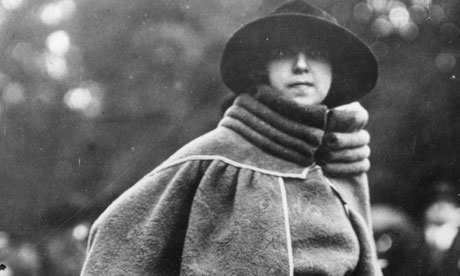
An ample cape with high collar was the latest fashion in 1914. Photograph: General Photographic Agency/Getty Images
In many respects London has never presented a more interesting array of fashions than at this season. The crowds of smart women from the Continent, and the prevailing quiet, good taste in dress is both restful and becoming at a time when everyone is feeling the depression of the war. After all, it is clearly a woman's duty to keep herself well dressed, though it may be on a slightly more economical scale than usual.
One is decidedly struck with the tendency to adopt - or rather adapt - several military styles of coats and capes. The cavalier cape of the summer has become more ample and closely fitting round the throat, while the loose military coat, slightly double-breasted and buttoning close to the neck, with a band collar or edging of narrow fur, is both extremely becoming and useful. These are usually made of a heavy face-cloth or velour, and must, of course, be lined with a silk of contrasting colour. An adaptation of the Russian soldier coat is another favourite. This is cut on somewhat straighter lines than the former and has a sash or girdle of heavy cord and tassel round the waist, tied loosely to the front or side.
House and Evening Gowns.
Here richness of tone and combinations of colour are very striking at the moment. With the sadly too necessary introduction of black - of which one sees more and more as the weeks go by - there is something particularly soothing in the rich shades which can be blended harmoniously with black, or at any rate which do not strike a discordant note. There is a sense of quiet sympathy, not of flaunting contrast. Warm browns and greens are perhaps most in evidence, blended with striped silk of many colours.
A very economical and becoming item for home wear is a simple blouse and tunic of black taffeta; the edge of the neck and front may be loosely button-holed with heavy black silk, and the long-ended sash round the waist edged in the same manner. This coarse button-holing is one of the latest ideas for edging. The advantage of such a tunic is that it can be worn over several skirts, such as velvet, soft silk, or a wool material, or even satin.
It is certainly wise to include black amongst one's gowns at this time, as occasions arise where it is more courteous to wear this colour for the sake of the feelings of others. A particularly charming evening gown for "all occasions" may be fashioned with black Chantilly lace, having the outer edge stitched on to a wide border of black silk net, this again being outlined with a narrow bordering of fur or a ruche of the net. For this one would suggest that the tunic should cross at the front and fall into long points on either side, nearly, if not quite, to the edge of the under-skirt; and then shaped or cut to come considerably higher on either side of the back, whence it falls again into a pointed train. Such an over bodice and tunic, if made by itself, can be worn over a white satin under-dress or one of whatever colour may be desired. These opportunities for sudden transformations are well to keep in mind at present.
via fashion - Google News http://news.google.com/news/url?sa=t&fd=R&usg=AFQjCNEZI1X1WYatCstFdHmpI6PhpVQbbA&url=http://www.theguardian.com/theguardian/2013/oct/23/first-world-war-military-fashion-1914




0 意見:
張貼留言